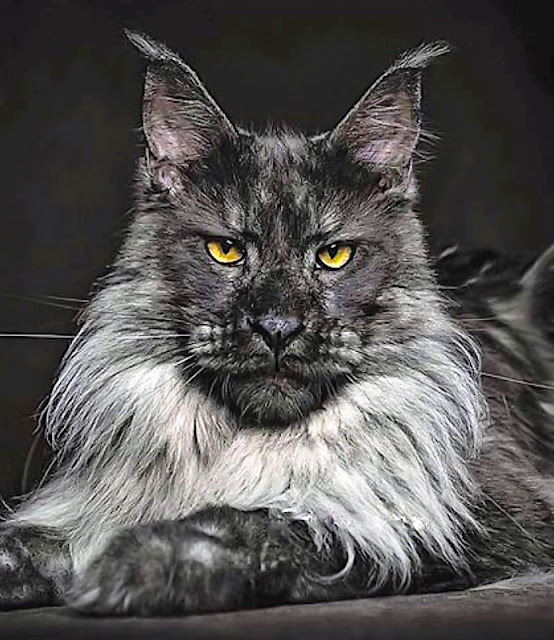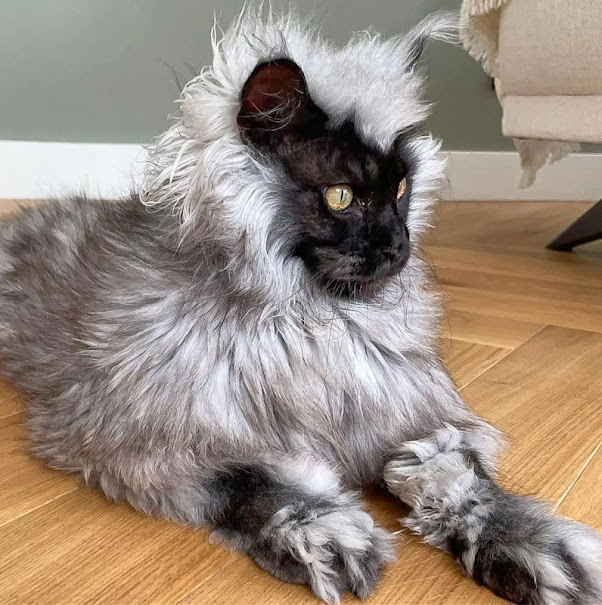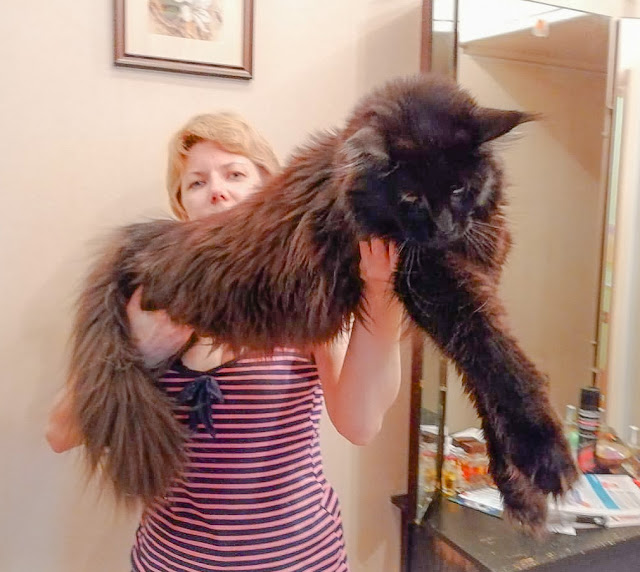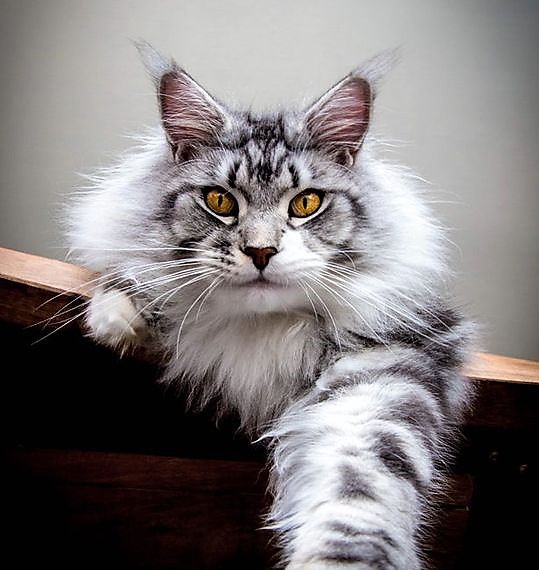Grooming a cat to help improve coat quality
The quality of a cat's coat is controlled by a number of factors:
- The cat's hormone concentrations;
- Nutrition;
- The general health of the cat;
- Parasitic infestations;
- The cat's genetics;
- How well the cat grooms herself;
- And finally, whether the cat's owner brushes their cat at all or how regularly.
When a cat grooms themselves their tongue, covered with backward facing spines made of keratin, combs their coat. The wet saliva is deposited on their fur which by the way is how people who are allergic to cats pick up the allergen as the saliva dries and flies off onto furniture. The saliva catches dirt and their tongue pulls out loose hair as they groom themselves. Mothers teach their kittens how to do this. And you will see allogrooming in which cats who are friendly with each other groom each other in an act of friendship.
 |
| Brushing a Maine Coon. Image: PetsKB. |
Grooming tips
Cats will normally keep themselves clean but when they get older or when they are ill it won't happen so well or at all. And certainly medium-longhaired cats and longhaired cats need the assistance of their owner to help keep their coat in excellent condition.
So, owners need to brush their cat regularly. I comb my cat with a flea comb all over because he is a shorthaired cat and this is feasible. The process combines three objectives: it makes him feel good therefore he enjoys the moment, it catches any fleas that may be present and it removes loose fur. It also massages the skin.
 |
| Grooming my cat by flea combing around his neck region which is where fleas congregate because a cat cannot groom their themselves. Photo: MikeB. |
The more hair you can remove the less will be licked off and swallowed or shed. Swallowed fur can lead to hairballs as you well know.
And if less hair is shed around the home it will no doubt please many people. You know what I mean: those loosely formed balls of cat hair that gets blown up against skirting boards in the living room. And when the sun angles low across a hardwood floor in the evening you can see all the hair. Far more than you had imagined!
Frequent brushing of your cat's coat helps to keep it sleek and healthy and free from parasites and other skin problems.
Shortly after kittens are weaned, they should be groomed in short sessions every day. A very soft bristle brush should be used and the session should be pleasant for both cat and person.
The frequency of grooming your adult cat depends upon the thickness and length of their coat and the condition of the skin and hair.
Brushing or combing a shorthaired cat should perhaps be done once a week but I do it daily. In contrast, longhaired cats such as the Maine Coon (medium-longhaired), Persian and Himalayans (pointed Persian and both longhaired) should be brushed/combed daily to prevent matting and tangling.
As cats become older even shorthaired cats will require more frequent coming.
You can use a comb as I do or a brush with natural bristles to produce less static electricity. Apparently, natural bristles produce less broken hair compared to nylon brushes. A "slicker brush" works well for most shorthaired cats. The wires feel like the spines on a cat's tongue and they are very good for removing dead hair.
Rex cats
For Rex cats i.e. Curly coated cats, an ultrashort-bristle brush or a brush with rubber nubs is the best. For Rex cats, if brushed in the normal way it can produce excessive hair loss and if brushed too vigorously. Some people use a palm brush or hand gloves which is used on shorthaired cats to remove dead hair and polish to coat. Chamois leather also works well and for hairless cats such as the Sphynx, a damp washcloth may be adequate most of the time.
Try to avoid static electricity. When brushing cats, it is possible to generate static electricity which can be uncomfortable for a cat. It may help to avoid this by dampening the brush first or you can mist it with a water spray. You can begin at the head and work towards the tail. I feel that the byword of this aspect of cat caregiving should be gentleness. It should be carried out at a pace and with such force which is perhaps unnatural for some men. Clearly, owners should not drive through matted fur because this will harm their cat. But hair mats should be removed.
Hair mats
If hair mats do develop it means that the owner is not brushing their cat frequently enough. Brushing a cat should prevent mats developing. Sometimes you have to employ a veterinarian to remove mats and if done at home it should be done with great care. I don't necessarily subscribe to using professional grooming parlours to do this job because they are unregulated and I don't think you can trust them.
The fine woolly hair in longhaired cats behind the ears and under the legs are two areas where mats form if neglected. You can buy commercial tangle removal liquids and sprays which may help to soften the mats to facilitate their removal. You first saturate the clumps of hair with these products which rehydrate the hair and closes the barbs on the hair strands. You then separate as much of the mat as you can with your fingers.
Some hair mats can be removed with the tip of a comb but most often they will need to be cut out. Obviously, using scissors should be carried out with extreme care. One issue is that a cat skins is not attached to the underlying muscle. It therefore "tents up" as the mat is pulled away from the skin. This can lead to the skin being cut. Do not slide the scissors beneath the mat and attempt to remove it next to the skin. That's too dangerous.
Where possible slide a comb beneath the mat to protect the skin and then hold the scissors perpendicular to the comb and carefully snip into the furball in strips. By perpendicular to the skin, I mean that the scissors point towards the cat and do not lie parallel with the cat. This avoids cutting the skin. After cutting the mat you can then tease it open with your fingers and then finally comb out the residual snarls.










Comments
Post a Comment
Please share your Maine Coon experiences.